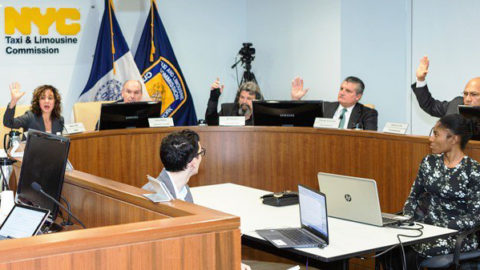New York City buses and taxis may soon be able to sense the movement of vehicles and the timing of traffic lights within a several-block radius as part of a trial program to reduce road injuries and deaths. The $25 million pilot will include 8,000 vehicles, which will be outfitted with special devices that can communicate with one another, as well as with roadside sensors, traffic signals and app-enabled smartphones.
The U.S. Department of Transportation (DOT) awarded New York City about $20 million for the pilot, which started in 2015. The city is contributing up to $5 million for the project.
The city has installed roadside sensors in Midtown Manhattan along a two-mile stretch of the FDR Drive and on First, Second, Fifth and Sixth avenues between 67th and 14th streets. Sensors also have been installed along Flatbush Avenue from Downtown Brooklyn to Grand Army Plaza. City transportation officials say the “connected-vehicle” technology would alleviate many common causes of accidents. It will alert the driver if he is at risk of running a red light, if a visually impaired person is in a crosswalk or if a car several vehicles ahead brakes sharply.
While autonomous vehicles use sensors that can see around a vehicle, connected vehicles use short-range communication similar to Wi-Fi to communicate with other vehicles, roadside sensors and smartphone apps. The technology has a range of 1,000 feet. Drivers would remain in control of their vehicles but would receive warning prompts if a hazard is nearby. The pilot also calls for 100 visually-impaired pedestrians to use an app that would help them cross the street.
The number of people killed on city roads has fallen in each of the past several years. There were 81 such fatalities during the first six months of this year, the fewest for any six-month period ever recorded, city officials said. In 2017, 214 people were killed in traffic accidents, they said.
About 70 vehicles are currently circling the city using prototype equipment. City officials expect to finalize contracts to outfit the remaining vehicles this winter. In the next year, up to 8,000 vehicles will be equipped with the technology, including nearly 6,000 yellow cabs, more than 1,000 MTA buses, 500 city and sanitation vehicles and 400 UPS trucks.
City officials emphasize that the data, which will be fed to the DOT, is anonymized and won’t be used to track individual drivers or vehicles. Automakers, such as General Motors Co. and Toyota Motor Corp., increasingly are including the technology in new vehicles, meaning it could become much more common in the coming years.
Source: The Wall Street Journal



